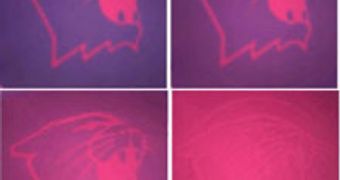In the near future, spies and top-secret agencies could have a lot to benefit from a new class of nanoparticle inks that was just created. Messages written with the new substance have a tendency to make themselves invisible, when viewed by suspicious strangers. The innovation, created by experts at the Northwestern University, led by Bartosz Grzybowski, a chemical and biological engineering professor, is made of gold and silver nanoparticles, which are placed on an organic gel film. The substrate is also flexible, which may lead to new applications for the discovery.
Messages, images or texts can be inscribed on the gel using a beam of ultraviolet light passed through an appropriate template, or by moving an ultraviolet pen over it, until the desired pattern is imprinted. Whenever exposed to visible light wavelengths, the messages in the gel gradually fade away, until nothing is left. The original ones that are imprinted take only a few milliseconds to appear, after the UV treatment. The disappearance act can be tweaked as well, so that the text vanishes in a few hours, or over a few days, depending on the required application.
Because of the substrate's properties, the medium can be written, cleared, and rewritten any number of times, with no decrease in quality. The entire ensemble can the twisted and bent, meaning it can withstand being handled rather roughly. A thorough description of the device can be found online, in the latest issue of the scientific journal Angewandte Chemie. In addition to using it for secure messages, the team also envisions self-expiring bus and train tickets, Technology Review reports.
The nanoparticles that make up the new inks are only five nanometers in diameter, the team announces, They are placed on the substrate in such a manner that they accept molecules that change shape under ultraviolet (UV) light being attached on top of them. “They're like a molecular glue that you can regulate using light,” Grzybowski explains. The unwritten films can be made in many colors, he adds. Gold-based ones are red, whereas silver-based ones are yellow, but even blue ones can be made, depending on how the team uses nanoparticles of different sizes.

 14 DAY TRIAL //
14 DAY TRIAL //